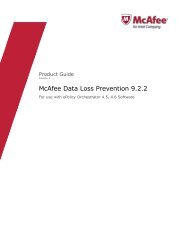Host Intrusion Prevention 7.0.0 for ePO 4.0 Product Guide - McAfee
Host Intrusion Prevention 7.0.0 for ePO 4.0 Product Guide - McAfee
Host Intrusion Prevention 7.0.0 for ePO 4.0 Product Guide - McAfee
You also want an ePaper? Increase the reach of your titles
YUMPU automatically turns print PDFs into web optimized ePapers that Google loves.
Configuring Firewall Policies<br />
Overview of Firewall policies<br />
If, however, the traffic does not meet the first rule’s conditions, <strong>Host</strong> <strong>Intrusion</strong> <strong>Prevention</strong> looks<br />
at the next rule in the list. It works its way down through the firewall rules list until it finds a<br />
rule that the traffic matches. If no rule matches, the firewall automatically blocks the traffic. If<br />
learn mode is activated, the user is prompted <strong>for</strong> an action to be taken; if adaptive mode is<br />
activated, an allow rule is created <strong>for</strong> the traffic.<br />
Sometimes the intercepted traffic matches more than one rule in the list. In this case, precedence<br />
means that <strong>Host</strong> <strong>Intrusion</strong> <strong>Prevention</strong> applies only the first matching rule in the list.<br />
Ordering the firewall rules list<br />
When you create or customize a firewall rules policy, place the most specific rules at the top of<br />
the list, and more general rules at the bottom. This ensures that <strong>Host</strong> <strong>Intrusion</strong> <strong>Prevention</strong><br />
filters traffic appropriately.<br />
For example, to block all HTTP requests except those from IP address 10.10.10.1, you need to<br />
create two rules:<br />
• Allow Rule: Allow HTTP traffic from IP address 10.10.10.1. This rule is more specific.<br />
• Block Rule: Block all traffic using the HTTP service. This rule is more general.<br />
You must place the more specific Allow Rule higher in the firewall rules list than the more<br />
general Block Rule. This ensures that when the firewall intercepts an HTTP request from address<br />
10.10.10.1, the first matching rule it finds is the one that allows this traffic through the firewall.<br />
If you placed the more general Block Rule higher than the more specific Allow Rule, <strong>Host</strong><br />
<strong>Intrusion</strong> <strong>Prevention</strong> would match the HTTP request from 10.10.10.1 against the Block Rule<br />
be<strong>for</strong>e it found the Allow Rule. It would block the traffic, even though you wanted to allow<br />
HTTP requests from this address.<br />
How stateful filtering works<br />
Stateful filtering involves processing a packet against two rule sets, a configurable firewall rule<br />
set and a dynamic firewall rule set or state table.<br />
The configurable rules have two possible actions:<br />
• Allow — The packet is permitted and an entry is made in the state table.<br />
• Block — The packet is blocked and no entry is made in the state table.<br />
The state table entries result from network activity and reflect the state of the network stack.<br />
Each rule in the state table has only one action, Allow, so that any packet matched to a rule<br />
in the state table is automatically permitted.<br />
The filtering process includes these steps:<br />
1 The firewall compares an incoming packet against entries in the state table. If the packet<br />
matches any entry in the table, the packet is immediately allowed. If not, the configurable<br />
firewall rules list is examined.<br />
NOTE: A state table entry is considered a match if the Protocol, Local Address, Local Port,<br />
Remote Address and Remote Port match those of the packet.<br />
2 If the packet matches an allow rule, it is allowed and an entry is created in the state table.<br />
3 If the packet matches a block rule, it is blocked.<br />
48<br />
<strong>McAfee</strong> <strong>Host</strong> <strong>Intrusion</strong> <strong>Prevention</strong> 7.0 <strong>Product</strong> <strong>Guide</strong> <strong>for</strong> use with ePolicy Orchestrator <strong>4.0</strong>

















